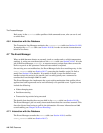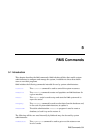allocate(1)
immediate=0 | 1
With a value of 1, this specifies that the request
should fail if it cannot be met immediately (this is
the same as the -I option).
hwbcast=0 | 1 With a value of 1, this specifies a contiguous range
of nodes and constrains the scheduler to queue the
request until a contiguous range becomes available.
rails=n In a multirail system, this specifies the number of
rails required, where 1 ≤ n ≤ 32.
Multiple requests can be entered as a comma-separated list, for
example, -R hwbcast=1,immediate=1.
-v Specifies verbose operation.
DESCRIPTION
The allocate program allocates resources for subsequent use by the prun(1)
command. allocate is intended for use where a user wants to run a sequence of
commands or several programs concurrently on the same set of CPUs.
The -p, -N, -C, -B and -n options control which CPUs are allocated. The -N option
specifies how many nodes are to be allocated. When this option is specified the user is
allocated a constant number of CPUs per node (default 1). The -C option specifies the
number of CPUs required per node. The alternative -n option specifies the total number
of CPUs to allocate. This option does not force the allocation of a constant number of
CPUs per node.
The -B option specifies the base of a contiguous range of nodes relative to the start of the
partition. The -N option specifies its extent. So for example -B0-N4 specifies the first
four nodes in the partition. Note that nodes that have been configured out are excluded.
The -B option should be used to gain access to a specific file system or device that is not
available on all nodes. If the -B option is used, the scheduler allocates a contiguous
range of nodes and the same number of CPUs on each node. Using this option causes a
request to block until the base node and any additional nodes required to run the
program are free.
The -p option specifies the partition from which CPUs can be allocated. CPUs cannot be
allocated from the root partition.
The Partition Manager, pmanager, allocates processing resources to users as and when
the resources are requested and become available. (See Section 4.4). By default, a
contiguous range of nodes is allocated to the request where possible. This enables
programs to take advantage of the system’s hardware broadcast facilities. The -R option
5-4 RMS Commands


















